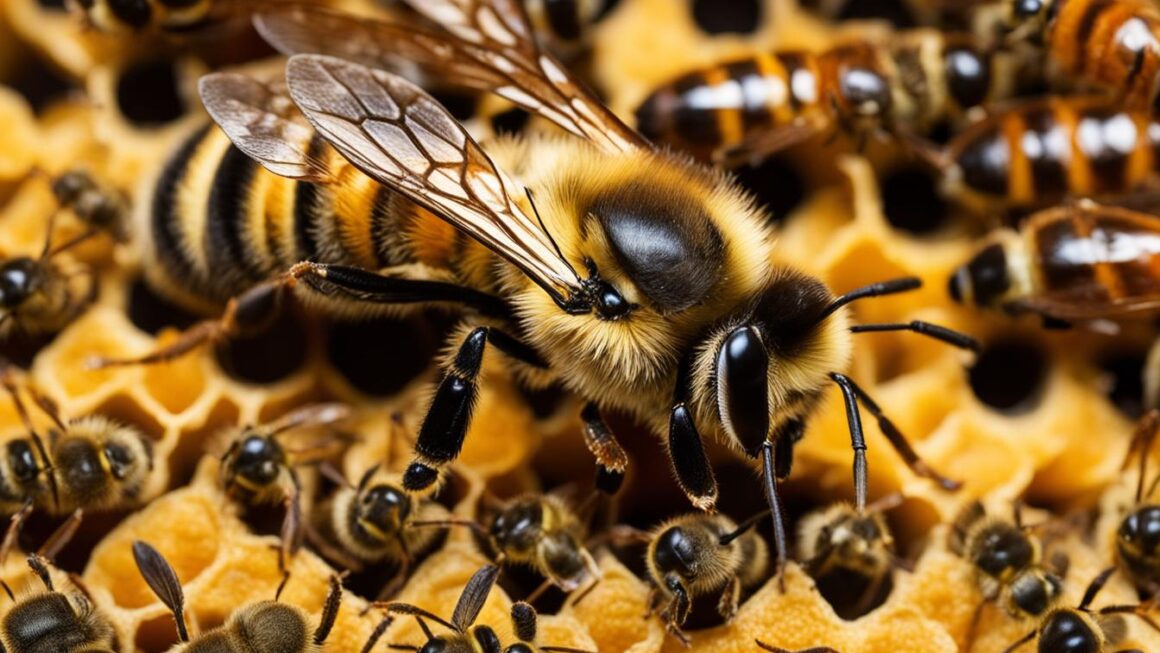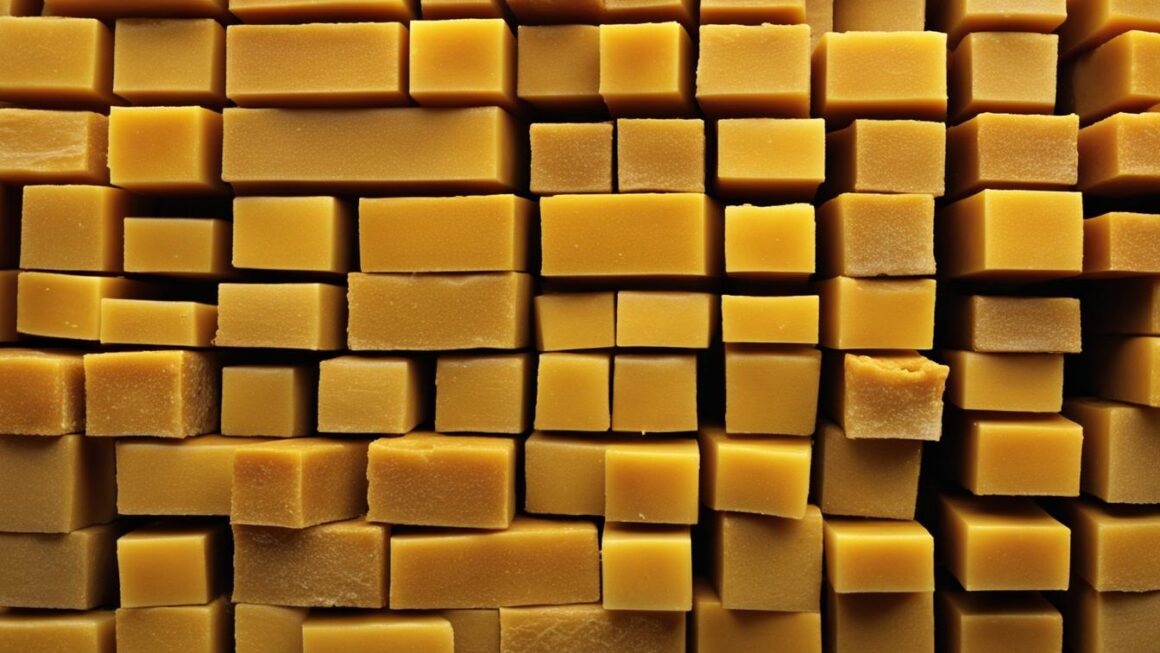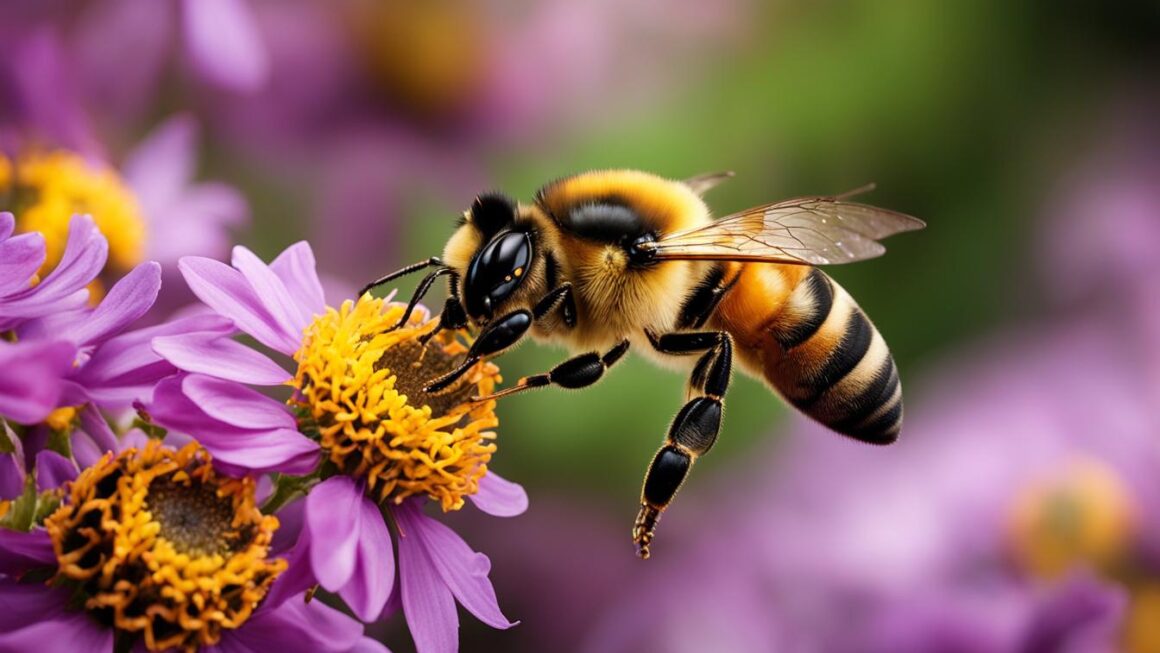Honey bees (Apis mellifera) are fascinating creatures with a complex social structure. Within their colonies, different individuals have varying life spans. In this comprehensive guide, we will explore the life span of a queen bee, focusing on key aspects such as the queen bee life cycle, factors affecting queen bee lifespan, and the queen bee reproductive cycle. Understanding the longevity and health of queen bees is crucial for the overall well-being of honey bee populations.
Key Takeaways:
- Queen bees have an average life span of 1-2 years.
- The queen bee life cycle involves mating with multiple drones and storing sperm for fertilizing eggs.
- Various factors can affect the queen bee’s lifespan, including genetics, reproductive activity, and environmental conditions.
- Understanding the factors that influence queen bee health and longevity is essential for maintaining healthy honey bee populations.
- Queen bee mortality rate can be influenced by factors such as predation, weather conditions, and their own behavior.
The Evolution of Longevity in Honey Bees
Honey bees are remarkable creatures that have evolved complex social structures, known as eusociality, which have allowed them to thrive for millions of years. One of the most intriguing aspects of honey bee biology is the dramatic difference in lifespan between the different castes. While worker bees only live for a few weeks, queen bees have a lifespan of 1-2 years, defying the normal trajectory of aging.
The evolution of longevity in honey bees has fascinated scientists for decades. Despite their high rates of reproduction, queen bees have evolved to live significantly longer than their non-reproductive counterparts. This unique adaptation raises questions about the evolutionary forces and molecular mechanisms that contribute to their extended longevity and fecundity.
The ability of queen honey bees to live longer can be attributed to a combination of factors, including changes in gene expression, reproductive physiology, and environmental influences.
Exploring the Factors Behind Longevity
Studies have shown that queen bees exhibit a slower rate of aging compared to worker bees, suggesting the presence of mechanisms that delay the onset of senescence. These mechanisms may involve changes in gene expression patterns and the activation of specific molecular pathways that affect various cellular processes, including DNA repair, oxidative stress response, and immune function.
Furthermore, the social environment and behavioral differences between queen bees and worker bees play a crucial role in determining their lifespan. Queen bees are well-nourished and pampered by worker bees, enabling them to allocate more energy towards maintenance and reproduction rather than foraging and other labor-intensive tasks.
| Caste | Average Lifespan |
|---|---|
| Queen Bee | 1-2 years |
| Worker Bee | 15-38 days (summer), 150-200 days (winter) |
| Drone Bee | 5-7 weeks |
Honey Bee Life History and Caste-Specific Differences
Honey bees have a fascinating life history characterized by caste-specific differences. This is due to their unique haplodiploid sex determination system, where unfertilized eggs develop into drones and fertilized eggs develop into workers or queens. The developmental times and lifespans of these different castes vary significantly, providing insights into the intricate workings of honey bee colonies.
Developmental Times
Let’s first explore the developmental times of the various honey bee castes. Drones, the male honey bees, have the longest developmental time of 24 days. Workers, the non-reproductive females, have a slightly shorter developmental time of 21 days. However, queens, the reproductive females, have the shortest developmental time of just 16 days.
Lifespans
The lifespans of honey bees also differ based on their caste. Drones have the shortest lifespan, living only 21-32 days. Workers, on the other hand, have longer lifespans that depend on the season. In the summer, their lifespan ranges from 15-38 days as they perform various tasks such as nursing and foraging. In the winter, their lifespan can extend up to an impressive 150-200 days. Queens, as the reproductive powerhouses of the colony, have the longest lifespan, living for 1-2 years.
Table: Developmental Times and Lifespans of Honey Bee Castes
| Developmental Time (days) | Lifespan (days) | |
|---|---|---|
| Drones | 24 | 21-32 |
| Workers | 21 | 15-38 (summer) 150-200 (winter) |
| Queens | 16 | 1-2 years |
These differences in developmental times and lifespans among honey bee castes contribute to the complex social structure and functionality of the colony. The short lifespan of drones aligns with their primary role in mating, while the longer lifespan of workers allows them to perform critical tasks throughout the seasons. The remarkable longevity of queens enables them to reproduce continuously and maintain the colony’s population.
Understanding the life history of honey bees and the caste-specific differences in developmental times and lifespans provides valuable insights into their biology and social organization. This knowledge is crucial for researchers and beekeepers alike, as it helps in the management and conservation of these vital pollinators.
Queen Bee Reproductive Cycle
The queen bee’s reproductive cycle is a fascinating process that involves mating flights, sperm storage, and egg-laying activities. Understanding this cycle is crucial for unraveling the mysteries of honey bee reproduction.
After emerging from her cell, the queen bee becomes sexually mature in just six days. She then embarks on mating flights, during which she mates with multiple drones from other colonies. These mating flights take place in the air, and the queen can fly several miles to ensure genetic diversity in her offspring.
One of the remarkable aspects of the queen bee’s reproductive cycle is her ability to store all the sperm she collects during mating flights. She stores the sperm in a specialized organ called the spermatheca, which can hold millions of sperm for her entire life. This enables her to fertilize eggs as needed, without the need for further mating.
After mating flights, the queen bee transitions into egg-laying activities. She can lay an astonishing number of eggs per day, ranging from 1,500 to 2,000. These eggs are deposited into individual cells within the hive, and they will eventually develop into worker bees, drones, or new queens, depending on the resources and needs of the colony.
Table: Queen Bee Reproductive Cycle
| Stage | Description |
|---|---|
| Maturity | The queen bee becomes sexually mature in 6 days after emerging from her cell. |
| Mating Flights | The queen mates with multiple drones during flights, ensuring genetic diversity. |
| Sperm Storage | The queen stores the sperm in her spermatheca for fertilizing eggs throughout her life. |
| Egg-Laying | The queen lays an incredible number of eggs per day, ranging from 1,500 to 2,000. |
The queen bee’s reproductive cycle is a testament to the complexity and efficiency of honey bee biology. By understanding this cycle, researchers can gain insights into the factors that contribute to the queen’s longevity and reproductive success, as well as the overall health and stability of honey bee colonies.
Worker Bee Lifespan and Seasonal Variation
The lifespan of worker bees, the non-reproductive female bees in a honey bee colony, varies depending on their role within the hive and the season. In the summer, worker bees live for 15-38 days as they perform various tasks such as nursing the brood and foraging for food. During this time, they work tirelessly to support the hive and ensure its survival. In the spring and fall, their lifespan can range from 30-60 days, allowing them to contribute to the growth and maintenance of the colony during periods of increased activity. In the winter, when resources are scarce, worker bees can live up to 150-200 days, enabling them to survive the colder months and maintain the hive until spring.
The transition from being a nurse bee to a forager bee is a significant milestone in the life of a worker bee. Nurse bees are responsible for caring for the brood, feeding them and maintaining the cleanliness of the hive. As they age, they undergo a physiological and behavioral transition, ultimately becoming foragers. Forager bees are tasked with collecting nectar, pollen, and water from the environment to sustain the hive. This transition is responsive to the changing social conditions within the colony, with the needs of the hive dictating the allocation of worker bees to different tasks.
The Nurse-Forager Transition in Worker Bees
The transition from being a nurse bee to a forager bee is a complex process regulated by various factors. As workers age, they experience changes in their hormone levels, gene expression, and brain function, which drive the transition. The responsibilities of nurse bees and forager bees require different physiological adaptations, and the transition allows workers to maximize their efficiency in the tasks they perform. This dynamic shift in roles and responsibilities ensures the smooth functioning and survival of the honey bee colony.
Factors Affecting Queen Bee Lifespan
The lifespan of queen bees can be influenced by various factors. Extrinsic mortality factors, such as weather conditions and predation, can have a significant impact on their longevity. Queen bees are especially vulnerable to extreme temperatures, as they require a stable and warm environment to thrive. Harsh winters or prolonged periods of cold weather can negatively affect their survival rates. Likewise, predators such as birds, spiders, and other insects can pose a threat to queen bees, potentially reducing their lifespan.
Furthermore, the behavior of queen bees can also play a role in their lifespan. Queen bees have distinctive responsibilities within the hive, including nursing and foraging. These activities require energy and can put additional strain on their physiological systems. The demands of egg-laying and maintaining the colony can contribute to the gradual decline in queen bee health over time.
It is important to note that while certain factors can impact queen bee lifespan, these insects have evolved mechanisms to mitigate the risks. For instance, queen bees have the ability to produce pheromones that regulate the behavior of worker bees. This chemical communication helps to ensure the well-being of the colony as a whole and provides some protection for the queen. Nevertheless, understanding the specific factors that influence queen bee lifespan is crucial in order to develop strategies for maintaining healthy honey bee populations.
Factors Affecting Queen Bee Lifespan:
| Factor | Impact |
|---|---|
| Extrinsic Mortality | Weather conditions, predation |
| Behavior | Nursing, foraging |
| Physiological Demands | Egg-laying, maintaining colony |
The Life Expectancy of Drones
Drones, male honey bees, have a relatively short lifespan compared to queen bees and workers. Their primary role within the hive is to mate with the queen and ensure the continuation of the colony. Once they successfully mate, their purpose is fulfilled, and they die shortly after. However, not all drones are fortunate enough to mate. In the winter, when resources are scarce, drones are expelled from the hive, as they no longer serve a productive purpose. This expulsion ensures that the remaining resources can be allocated to the surviving members of the colony.
The average lifespan of a drone is around 5-7 weeks. During their short lives, drones have the opportunity to embark on mating flights, where they search for virgin queens from other colonies. These flights are crucial for the survival of the honey bee population, as they ensure genetic diversity within the species. However, not every drone is successful in mating, and competition among drones can be intense.
The limited lifespan of drones highlights their sacrificial role in the honey bee society. While their individual lives may be short, they play a critical part in the reproductive cycle of the colony. Without drones, queen bees would not be able to mate and produce new generations of worker bees, ultimately leading to the demise of the colony as a whole.
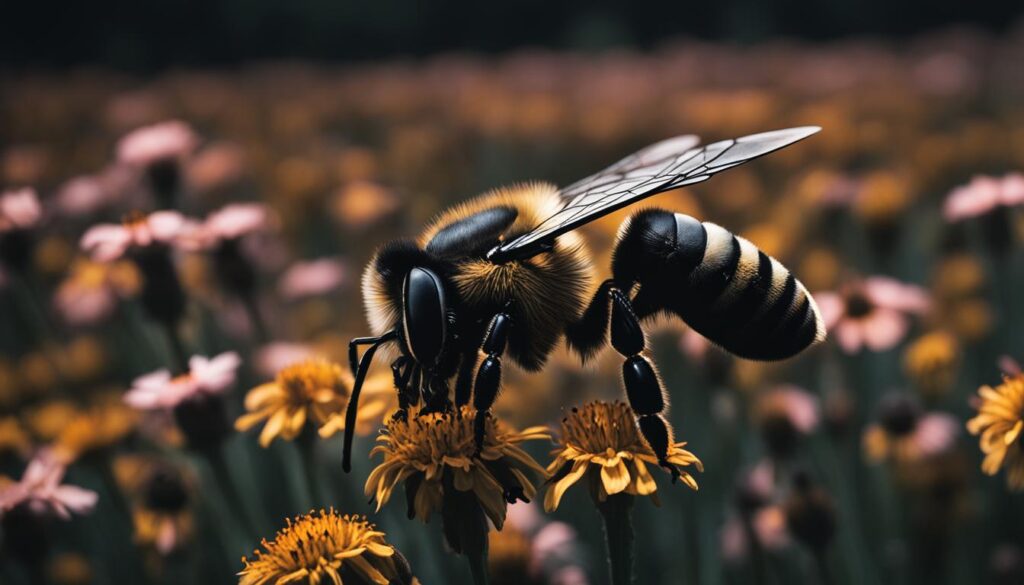
Table: Lifespan of Honey Bees
| Bee Caste | Average Lifespan |
|---|---|
| Queen bee | 1-2 years |
| Worker bee (summer) | 15-38 days |
| Worker bee (winter) | 150-200 days |
| Drone | 5-7 weeks |
Other Types of Bees
While honey bees are well-known for their crucial role in pollination and honey production, there are many other types of bees that play an important part in our ecosystems. These bees have their own unique characteristics and behaviors, making them fascinating creatures to study and observe.
One such type is the bumble bee. Bumble bees are known for their large size and distinctive buzzing sound. They are excellent pollinators and are capable of performing a behavior called “buzz pollination,” where they vibrate their flight muscles to release pollen from flowers.
Leafcutter bees, on the other hand, are known for their remarkable ability to cut perfectly circular pieces of leaves. They use these leaf pieces to construct nest cells where they lay their eggs. Leafcutter bees are important pollinators of various plants, including alfalfa, blueberries, and roses.
Mason bees are solitary bees that construct nests using mud or other natural materials. They are efficient pollinators and are often used in orchards to increase fruit yields. Mason bees are known for their gentle nature and do not typically sting unless provoked.
Mining bees are another type of solitary bee that excavates tunnels in the ground to create their nests. They collect pollen to provision their offspring and are essential pollinators for a wide range of plants.
We cannot forget about carpenter bees, which are known for their ability to create nests by excavating tunnels in wood. While they may cause damage to wooden structures, they are important pollinators, especially for plants that have deep tubular flowers.
These are just a few examples of the many different types of bees that exist. Each type has its own unique adaptations and contributions to ecosystems. By learning about and appreciating the diversity of bees, we can better understand and protect these valuable pollinators.
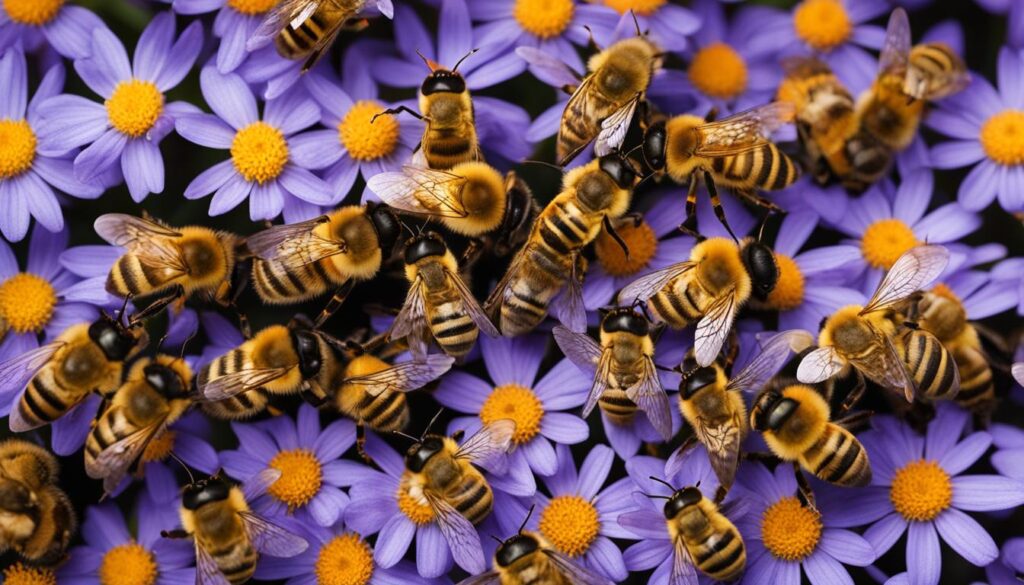
Conclusion
In conclusion, the life span of a queen bee is influenced by various factors. Genetics, reproductive activity, and environmental conditions all play a role in determining how long a queen bee will live. On average, queen bees have a lifespan of 1-2 years, during which they mate with multiple drones and lay thousands of eggs. Their ability to store sperm and constantly produce offspring contributes to their unique reproductive cycle.
Compared to queen bees, worker bees have much shorter lifespans. Their lives are divided into different roles within the hive, such as nursing and foraging, and their lifespan can vary depending on the season. In the summer, workers live for 15-38 days, while in the winter, they can survive up to 150-200 days. Drones, on the other hand, have a lifespan of only 5-7 weeks and serve the sole purpose of mating with the queen.
Understanding the factors that affect the life span of queen bees is crucial for studying their biology and maintaining healthy honey bee populations. Factors such as extrinsic mortality, weather conditions, predation, and behavior all contribute to the longevity of queen bees. By unraveling the mechanisms that allow queen bees to achieve long lifespans while maintaining high fecundity, researchers can gain valuable insights into the unique biology of these remarkable insects.
Overall, the life span of a queen bee is a fascinating subject that showcases the complexity of honey bee societies. By delving into the factors that control their life span, we gain a deeper appreciation for the remarkable abilities and characteristics of these essential pollinators. Understanding their life span is not only important for the scientific community, but also for the conservation and preservation of honey bee populations worldwide.
FAQ
What is the life span of a queen bee?
Queen bees can live for an average of 1-2 years.
How long do worker bees live?
Worker bees have a lifespan of 15-38 days in the summer and 150-200 days in the winter.
How long do drones live?
Drones have a lifespan of 21-32 days.
What factors influence the life span of queen bees?
The life span of queen bees can be influenced by factors such as genetics, reproductive activity, and environmental conditions.
How many eggs can a queen bee lay per day?
Queen bees can lay 1,500-2,000 eggs per day.
What is the role of drones in a hive?
Drones’ primary role is to mate with the queen.
How do worker bees transition from being a nurse to a forager?
The transition from being a nurse to a forager is responsive to changing social conditions.
What are some other types of bees?
Other types of bees include bumble bees, leafcutter bees, mason bees, mining bees, and carpenter bees.

